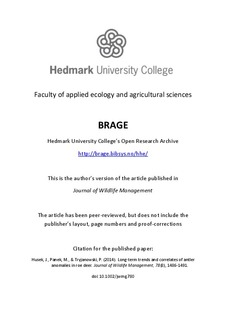| dc.contributor.author | Husek, Jan | |
| dc.contributor.author | Panek, Marek | |
| dc.contributor.author | Tryjanowski, Piotr | |
| dc.date.accessioned | 2015-03-02T09:09:47Z | |
| dc.date.available | 2015-03-02T09:09:47Z | |
| dc.date.issued | 2014 | |
| dc.identifier.citation | Husek, J., Panek, M., & Tryjanowski, P. (2014). Long-term trends and correlates of antler anomalies in roe deer. Journal of Wildlife Management, 78(8), 1486-1491. doi: 10.1002/jwmg.780 | nb_NO |
| dc.identifier.uri | http://hdl.handle.net/11250/278083 | |
| dc.description.abstract | Length and structural complexity of antlers provide an indication of individual quality in many ungulates in the context of female mate choice and trophy hunting. Selectivity of hunters for individuals with various antler sizes may have bearing on the population structure. It is less well understood, however, whether and how antler anomalies may signal individual characteristics. We used data on 2,461 roe deer (Capreolus capreolus) males harvested by stalking during 1966–2011 in western Poland to test hypotheses explaining probability of occurrence of accessory, broken, and malformed antlers. By employing a multinomial logistic regression, we showed that the probability of occurrence of broken and malformed antlers increased in males older than 2 years. Probability of occurrence of accessory and, in young males, broken antlers was higher in individuals with increased body weight. Occurrence of malformed antlers decreased over the study period. Contrary to our prediction, we did not detect an effect of distance to forest on the probability of malformed antlers occurring. We conclude that the main premise of compensatory culling is not supported in roe deer | nb_NO |
| dc.language.iso | eng | nb_NO |
| dc.publisher | Wiley | nb_NO |
| dc.subject | age | nb_NO |
| dc.subject | antler | nb_NO |
| dc.subject | body mass | nb_NO |
| dc.subject | Capreolus capreolus | nb_NO |
| dc.subject | harvest | nb_NO |
| dc.subject | habitat gradient | nb_NO |
| dc.subject | malformation | nb_NO |
| dc.subject | trend | nb_NO |
| dc.subject | trophy | nb_NO |
| dc.title | Long Term Trends and Correlates of Antler Anomalies in Roe Deer | nb_NO |
| dc.type | Journal article | nb_NO |
| dc.type | Peer reviewed | nb_NO |
| dc.source.pagenumber | 1486-1491 | nb_NO |
| dc.source.volume | 78 | nb_NO |
| dc.source.journal | Journal of Wildlife Management | nb_NO |
| dc.source.issue | 8 | nb_NO |
| dc.identifier.doi | 10.1002/jwmg.780 | |
